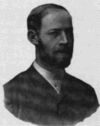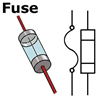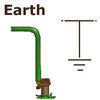Many household items run from batteries, but the many larger electrical appliances like heaters, lights, cookers, refrigerators, computers and so on require a continuous power supply than batteries cannot provide. The electrical energy that can be transferred to an appliance each second is the product of voltage and current. The higher the voltage and current, the more energy is transferred. Ordinary dry cells provide only about 1.5 volts with a low current, while the household mains supply provides 240 volts with much higher available currents.
The other major difference is that dry cells deliver their energy using direct current (DC), while the mains in your home is alternating current (AC).
Direct current
As the name implies the current flows directly around a circuit, with
electron charges traveling from the (flat) negative terminal of a cell
to the (protruding) positive terminal in one direction only. Dry cells,
car batteries, and solar panels are examples of DC electrical sources,
and the telephone exchanges in Australia operate on a 48 volt DC supply.

|
The simplest circuit |
 Alternating
current
Alternating
current
Alternating current in your home reverses the current 50 times each second.
It has a frequency of 50 Hz. The unit is named after Heinrich Hertz (1857-1894).
There are several advantages to using AC current, including:
- Alternating current is much easier to generate in high voltages and
currents.
- AC can readily be transformed to higher or lower voltages. High voltage
transmission of power to your home reduces energy loss in the cables.
- AC motors are cheaper and easier to maintain than DC motors.
Power in your home
Another electrical unit that you will see in your home is the watt. This
unit was named after James Watt (1736-1819), and is an indication of how
much electrical energy per second is transformed by an appliance into
another form of energy. For example, a standard light globe might have
60 watts marked on it, meaning it will transform 60 Joules of energy each
second into light and heat. A heater labeled 2500 watts transforms 2500
Joules of energy each second into heat .
Power is related to voltage and current by the formula power = voltage multiplied by current. For a heater of 2400 watts, with a voltage of 240 volt, the current is 2400/240 = 10 amp. This is the maximum current that can safely pass through a conventional power point, so the maximum power that can safely be transformed, without blowing a fuse or jumping the circuit breaker, is usually 2400 watt.
 How much current will a 60 watt globe draw when connected to a 240
volt power supply? To find out you have to rearrange the formula. You
need to know the current, so by simple transformation, the formula becomes:
How much current will a 60 watt globe draw when connected to a 240
volt power supply? To find out you have to rearrange the formula. You
need to know the current, so by simple transformation, the formula becomes:
current = power divided by voltage. In this case it is 60 watt / 240 volt = 0.25 amp.

One reason why piggyback plugs are not a good idea in a power point is that although any individual item may draw less than 10 amp, the combination of several items could well exceed the limit and cause a fire in the wiring. Each home and factory has a safety system in place to prevent fires from happening, this safety feature is called a fuse or circuit breaker.
 Fuses
Fuses
The word fuse means to melt and that is exactly what a fuse in
your household supply box does. As charge flows through the fuse wire,
it heats up. If the circuit is overloaded, then the fuse wire gets very
hot, melts, and breaks the circuit, cutting off current to the appliances
connected on that circuit. A common phrase is that the fuse has "blown".
Sometimes a fuse blows because there is a fault in an appliance and a
'short circuit' has been created producing a sudden surge of current in
the circuit. Circuit breakers work in a similar way to fuses, but physically
jump and break the circuit. The appliance is usually protected, but you
may not be! That's where another safety feature comes into play - the
Earth connection.
 Most electrical plugs have three pins. Two of them are for the charge
to flow through and the third, a longer one, is connected to a wire in
your house that leads straight to an Earth connection - often a metal
pipe buried in the ground. If a wire comes loose in an appliance, it could
touch a metal part and pass through you to Earth, with possible fatal
results. The Earth connection provides an easier path for the current
to flow, so it takes that path instead.
Most electrical plugs have three pins. Two of them are for the charge
to flow through and the third, a longer one, is connected to a wire in
your house that leads straight to an Earth connection - often a metal
pipe buried in the ground. If a wire comes loose in an appliance, it could
touch a metal part and pass through you to Earth, with possible fatal
results. The Earth connection provides an easier path for the current
to flow, so it takes that path instead.
| Copyright owned by the State of Victoria (Department of Education and Early Childhood Development). Used with Permission. |